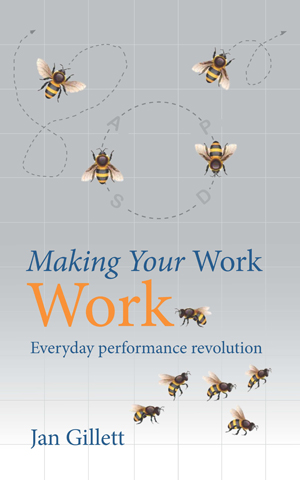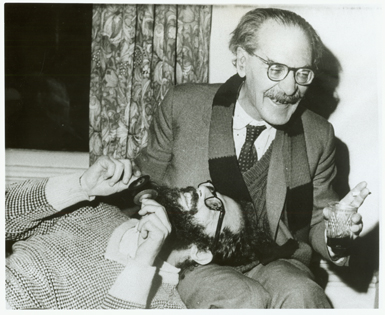Author Archives: Infinite Ideas
10 tips to achieve restful sleep
12 March 2014 by Infinite Ideas in Business and finance
by Kate Cook, author of The Corporate Wellness Bible
According to the BBC, 25% of the UK population experience problems with their sleep. At work, this can cause problems in terms of alertness (obviously) and knock on issues with stress. One third of people in the UK are classed as insomniacs, which includes those who can’t get to sleep as well as those waking in the night or waking early. Tiredness can lead to a vicious cycle in terms of reaching for caffeine (and issues  with anxiety from caffeine), reaching for sugary snacks to try and pick up energy (not the right thing in the long term!) and even increasing alcohol consumption.
with anxiety from caffeine), reaching for sugary snacks to try and pick up energy (not the right thing in the long term!) and even increasing alcohol consumption.
If you are suffering from insomnia here are my favourite top 10 tips for a restful night:
1. Don’t watch TV in the bedroom or have any other electrical equipment in the bedroom. Switch your phone on to airport mode and the do not disturb function;
2. Don’t have the clock where you can see it! If you don’t know the time you can’t fret about how many hours you have until the alarm goes off. Let go of having to know;
3. Make sure your room is sufficiently darkened at night (for the production of a hormone called melatonin, important in the sleep cycle);
4. Try moving your bedroom into a different configuration;
5. Don’t let your room get too warm, and sleep with a window open if there is no security risk;
6. Breathe! Learn mindfulness, a powerful technique to counter the stress cycle;
7. Try the Pzizz app. Designed by sleep experts to break the non-sleep cycle;
8. Avoid foods that contain an amino acid called tyramine (amino acids are the building blocks of protein). Some foods that contain tyramine are red wine, cheese, ham, raspberries, avocado and nuts;
9. Eat foods that convert into the hormone serotonin from the amino acid tryptophan (best consumed with a small amount of carbohydrate like brown rice – turkey, cottage cheese and eggs amongst other sources;
10. Cut down (or eliminate) caffeine. Remember caffeine can stay in the system for at least 6 hours – even if you think it doesn’t affect you, it probably does!
And a couple of bonus tips for you too:
Bonus one: Remember we haven’t always slept in the pattern we do today – apparently in the Middle Ages people would get up after a few hours, have a party, then go back to sleep. After four hours, much of the restorative benefits of sleep are received – it’s mostly us getting in a state about not sleeping that causes the stress, anxiety and worry.
Bonus two: Try and eat earlier so that your digestive system is not struggling and stopping you sleeping.
Happy Dreams!
Kate Cook is one of the UK’s top Wellness and Nutrition experts and is leading a campaign to promote wellness in UK corporations. For more information please visit Kate’s website or email Richard Burton to enquire about The Corporate Wellness Bible.
Make your work work better with management expert Jan Gillett
11 March 2014 by Infinite Ideas in Business and finance
Develop a process that puts the customer at its heart and you will find yourself with a business that’s streets ahead of the competition.
It may sound simple but as business management expert Jan Gillett points out it is essential that businesses do not get distracted from the big picture – creating a product or service that provides what the customer wants – by all manner of day to day management tasks.
This is particularly true now the economy is picking up. Companies have been so intent on keeping their heads above water that they haven’t felt able to take a long view of their business. But this is not a strategy that can pay off indefinitely. As Gillett says, “Organisations that focus on the owners, treat customers with disrespect and try to cut costs and get away with it are not rewarding environments in which to work, and apart from lucky times when they can dominate customers they are not very successful either.”
Many just don’t know where to start and while investment in generic tools or practices will get you so far, true business success can only be achieved when all key personnel take time to understand the way the business works and engage staff and stakeholders in a programme of change. In other words they have to think about how the work works.
Anybody familiar with the work of Dr W. Edwards Deming will realise that this idea is not new. His work based on these principles, his System of Profound Knowledge, formed the foundation of manufacturing success in Japan during the 1950s and has gone on to help businesses worldwide, and in a broad range of sectors, achieve long-term success. What is surprising is how few businesses have really tried to get to grips with Deming’s ideas. Perhaps it is down to our quick-fix culture – it’s true that this method requires more engagement than some ‘off the peg’ solutions. But it also delivers far greater rewards.
Over the last 30 years Gillett has worked with many clients through Process Management International, but is aiming to introduce a new wave of businesses to Deming’s revolutionary ideas with his book, Making your work work. Gillett provides all the ideas and methods managers at any level need in order to improve the performance of their department, division or company, and demonstrates how to use them. With the economy currently in recovery this could be the perfect opportunity for British companies to push themselves to the fore and emerge as market leaders.
About Jan Gillett (FCMI)
Jan learned from Dr W. Edwards Deming when leader of a quality transformation across 2000 people, when CEO of a textile services group in the 1980s. He experienced the remarkable benefits to be had when focusing the work on the customers, involving everyone in learning how it flows, and getting the results on target with minimum variation. Between 1990 and 2009 he built and co-led Process Management International Ltd, helping clients across the world to achieve better results by transforming their approach to their strategy and everyday work; as deputy chairman he retains a strong link with the company. He is co-author of Working with the Grain: Uncommon Sense for Leaders.
Making Your Work Work – Everyday performance revolution | Jan Gillett | 216 x 135mm | 17th March 2014 | 224 pages | ISBN: 9781908984203 | Paperback | £18.99 | BIC code: KJ – Business & management
Contact at Infinite Ideas Richard Burton: richard@infideas.com
Author web site: http://www.pmi.co.uk
My book is with the printer. What can be the quality target?
18 February 2014 by Infinite Ideas in Business and finance
by Jan Gillett, author of Making your work work
After nine months of thought, research, writing and checking, Making your work work is in the hands of the printer – it’s too late to change anything now. In a few weeks several thousand copies will arrive.
Readers are likely to have high expectations about the quality of a quality-management related book. But how can we assess the quality of a book? Does the quality management world provide meaningful targets, or do we have to look elsewhere?
Have I got it ‘right first time’?
Well, the answer depends on what you mean by ‘right’, and ‘first time’. It’s a little longer than the original estimate, so in that sense it’s already not right. It’s been read by half a dozen people, and I’ve incorporated most of their observations, so right or not, that’s hardly ‘first time’. After considering proof reading it’s actually more like third or fourth time. Is that an indication of success, or failure?
Actually it’s inevitable. In addition, when the intended market (readers who don’t already know very much about using process or quality management for everyday work) sees it, it’s virtually certain that their feedback will lead to changes for a second edition. So, no, it can’t be ‘right first time’, and in fact having such an aim would paralyse creative work.
But I do of course hope that it is right enough to get a good reaction and for people to recommend it. Then we could do a second edition, which would also take several iterations in development.
So ‘right first timer isn’t a helpful target in this case. But it can be. Consider a self-assembly furniture item. Having a high level of right first time achieved by the customers would be great.
Are there ‘zero defects’?
Another deathless phrase, swallowed without thought by many big companies as a target for a change programme before it collapses in the face of real products and services, real customers. It sounded fine in concept, but application shows the arbitrary nature of virtually all definitions of a defect. Agreement between producer and user over an extended time about what a defect is, is effectively impossible.
No doubt there would be as many definitions of defect in a book as there are readers, so this target is not going to work.
Some zero targets, such as deaths from accidents, are real enough, in fact in that case any other target is an insult, but they are the exception.
Could the book achieve ‘Six Sigma’?
If not zero defects then, what about the six-sigma target of about 3 errors per million opportunities? Since PMI is a leading consultancy and training firm in Six Sigma we should be able to achieve that, shouldn’t we? But, and it really isn’t an excuse, let’s consider this one carefully too.
If, regardless of the above, we assume we could agree what a defect is (the customer’s tolerance) my book, with about 70,000 words in all, would need to have no errors at all. Hmm, anyone who has written more than a page or two will see the nonsense here. A Six Sigma achievement would be one error in the entire contents of a small library. In fact, one error per chapter would be pretty impressive, and that with a lot of effort in multiple reviewing, proof reading and so on. That’s about Four Sigma, apparently not much to shout about.
In fact this shows that ‘Six Sigma’ as a target should be used with great care. When used as originally by Motorola to drive up the quality of mass production of new electronic devices, it was transformational. The problem is that it has been adopted so carelessly that for many it is devalued. As a target for publishing it’s no help. Incidentally, if six-sigma as a target isn’t sensible for an organisation, then Six Sigma as a programme name is also not helpful.
How about an older ambition ‘on target with minimum variation’?
Going back more than forty years, in fact to the early 1960s, we arrive at this phrase, credited to Genichi Taguchi. Although it somehow seems less demanding than the specification-based western rallying cries of zero defects and so on, it is in fact a profoundly rigorous term, that you can apply to every circumstance.
If you seek to get your outputs ‘on target with minimum variation’ you need to:
- appreciate what your customer values;
- establish criteria that you can measure, both of the customer characteristics and of your output;
- understand the process that leads to the output, and its context (how the work works);
- optimise the operation of the process to get the mean of the outputs close to the target, and with minimum variation about the mean.
If you are making crankshafts this philosophy enables you to achieve better than six-sigma, in fact it’s pretty routine. Those who have watched Don Wheeler’s video ‘A Japanese Control Chart’ will recall that the factory produced many millions of parts with none out of specification.
And it works just as well for a call centre manager trying to do their best with the variety of queries coming in on the phone.
Will Making your work work be on its target, will the variation be acceptable?
I have tried to keep in mind as my target audience everyday managers trying to achieve better and more predictable output from their work. Regular managers don’t have time for complications, but do need some analogies, inspiration and explanations. Thus every topic presented temptations to expand, to illustrate or to go into more detail, but doing too much would be going off target. Time will tell if I have achieved an acceptable compromise.
What about errors? Well here’s a minefield illustrating exactly the problem with defining what a defect is. Obvious ones like spelling surely? Well yes and no, for US or Indian English is not the same as English English. Well how about punctuation and phrasing? Much of that is opinion, with academics disagreeing. Some errors would really be wrong – at one stage in the writing process I found I had written customer when I meant supplier, and I’m glad to have spotted that! But most are not even likely to be noticed! At PMI we found an error in one of our manuals recently that can be traced back to the early 1990s. Nobody had spotted it before. This is a manifestation of the age-old question ‘if a tree falls in the forest, but no-one is there to hear it, does it make a noise?’ which I explore at some length in the book.
None of which means that we have not tried very hard indeed to eliminate errors, but no doubt some will have slipped through. Most readers will have examples of how inspections fail to pick up errors, so I must brace myself for being informed of some that we missed, and to figure out how to respond!
Conclusion: the most important characteristics are unknown, and probably unknowable
 This was one of Dr Deming’s many infuriating claims in the 1980s that would cause a regular manager (as I was in those days) much frustration. Only after a lot of reflection did it make sense. We had all been captured by the finance discipline, so that we were used to putting everything in numbers. In fact one particularly useless cliché that still survives is: ‘If you can’t measure it you can’t manage it’. Dr Deming said that was wrong, and that was hard to take. But he was right of course. Numbers are an abstraction of reality, not the reality itself. The appeal of a Lexus over a BMW, or vice versa, is a matter of opinion, worth billions, but not actually measurable.
This was one of Dr Deming’s many infuriating claims in the 1980s that would cause a regular manager (as I was in those days) much frustration. Only after a lot of reflection did it make sense. We had all been captured by the finance discipline, so that we were used to putting everything in numbers. In fact one particularly useless cliché that still survives is: ‘If you can’t measure it you can’t manage it’. Dr Deming said that was wrong, and that was hard to take. But he was right of course. Numbers are an abstraction of reality, not the reality itself. The appeal of a Lexus over a BMW, or vice versa, is a matter of opinion, worth billions, but not actually measurable.
So I hope my book appeals enough to people to inspire them make their work work better, and that they also come up with ideas that will help me make the second edition better still.
How twenty-first century technology can help you quit smoking for good
4 February 2014 by Infinite Ideas in Lifestyle
Last week the news broke that a fifth former Marlboro Man, Eric Lawson, has passed away due to smoking related causes (read about it here). It got us wondering how many people started 2014 resolving to fling the fags for good; and how many stuck to it. We all know people who are trying desperately to quit – maybe your boss is giving up again, your best mate has tried all the latest gadgets in her quest, or Uncle Larry is constantly covered in nicotine patches and just wants to feel free again. If you’re a heavy smoker yourself, your teeth are probably stained, your fingers may be yellow and your careworn family are very likely at their wits’ ends. Quitting smoking is never going to be easy, but these days there are many routes to success and they don’t necessarily involve going cold turkey. Here are some options we’ve tried:
- The cold turkey approach: purge your house and pockets of cigarettes, resisting the urge to go scrambling after them in a nicotine-fuelled frenzy (superior willpower required – only 3% of smokers succeed by willpower alone);
- Get your hands on one of the latest e-cigarettes, such as Green Smoke, designed to take some of the nasties (and social stigma) out of smoking;
- Search the web for online stop smoking campaigns such as Stoptober and quit together with thousands of others;
- Nicotine patches. Lots of them;
- If you live in the UK, check out the range of support services provided by the NHS;
- Download a stop smoking app on your Android or iOS device (most popular at the moment are NHS Stop Smoking and Smoke Free);
- Websites. Many stop smoking charities, such as Quit, have sites where you can access information, shop for stop smoking products, develop your own ‘Quit Plan’ and find out where you can get the best support;
- Ditch your chain-smoking friends and start your new life as a Buddhist monk;
- Buy Stop Smoking or Quit Smoking for Good, read it from cover to cover and then tell all your friends and colleagues how life-changingly fantastic it is.
Ten years ago this list would have been a lot shorter. The recent growth of stop smoking products is due in part to smoking bans, making it far more inconvenient to smoke in public. Products such as electronic cigarettes, combined with online campaigns, supportive communities on social media sites and the many practical stop smoking apps available, have made us better equipped than ever to give up for good (the wonders of modern technology!) So if you don’t fancy going cold turkey or giving up your day job to seek enlightenment, have no fear – there’s probably another option for you (and probably for the big boss, Sarah and Uncle Larry, too)…
How to understand and apply the world’s most powerful business tools
20 January 2014 by Infinite Ideas in 100+ Management Models, Business and finance
Fons Trompenaars and Piet Hein Coebergh explain the eight dominant management trends that form the basis for their analysis of 100+ Management Models.
Bunting and Biography
16 January 2014 by Infinite Ideas in Basil Bunting and A strong song tows us, Book publishing
by Richard Burton, author of A strong song tows us
The old man in August Kleinzahler’s beautiful poem ‘The Bench’ is the poet Basil Bunting, the location Victoria, British Columbia, during Bunting’s disastrous winter at the University of Victoria in 1971-72 (LRB, 9 January). After a spectacular falling out with Robin Skelton, Bunting was left isolated, lonely and bitter, but Kleinzahler shows him keeping his eye on the horizon. Bunting’s preference was for the big picture but he also had a keen appreciation of the absurd and he would have relished some of the eccentricities in Michael Hofmann’s review of my Life of Bunting in the same issue. I am still trying to work out what an ‘exfoliated, whiskery’ biography might look like, and whether or not I have written one, and whether or not it is a good thing if I have; and I’m sure that Bunting would have found the comparison of the poet to Tintin as bewildering as I do. It’s not for me to quibble with Hofmann’s interpretations but I should correct the impression he may have left that Bunting’s relationship with biography was straightforward, because it wasn’t.
Hofmann writes that mine is the first ‘proper’ biography of Bunting but that I add little to his understanding of its subject beyond that provided by Victoria Forde, Richard Caddel and Carroll Terrell. He doesn’t mention Keith Alldritt’s The Poet as Spy: The Life and Wild Times of Basil Bunting, which was published in 1998. Forde and Terrell did include biographical chapters in their studies of the poet, and a clue to the strengths and weaknesses of Basil Bunting: A Northern Life by Caddel and Anthony Flowers, which is just 64 pages long and heavily illustrated, is embedded in its subtitle. Alldritt’s was in fact the first ‘proper’ biography but it is so heavily marbled with rumour and speculation that it is almost worthless. It was reading Alldritt’s book (which if anything damaged Bunting’s reputation) that stung me into writing A Strong Song Tows Us.
More important, Hofmann writes that I pay ‘lip service to Bunting’s personal opposition to biography’ and that I go ‘so far as to borrow the five parts of Briggflatts’ for my narrative structure. That often expressed objection is, however, compromised by Bunting’s full participation in the publication of Jonathan Williams’s Descant on Rawthey’s Madrigal, which told his story up to the mid-1960s, by his biographical introduction to the poems of Joseph Skipsey in 1976, in which he confesses to having sought out Skipsey’s surviving relatives for their memories, and by the fact that the subtitle of Briggflatts itself is ‘An Autobiography’. Bunting was not above using biography in pursuit of what he saw as a good cause. He did this because he recognised that the way to interest people in the work of a neglected poet is to tell his story. My ‘borrowing’ from Briggflatts was intended as a courtesy and recognition of Bunting’s ambiguous relationship with biography. Hofmann doesn’t seem to be too comfortable around ambiguity. He chides me for not telling readers whether Bunting was arrested in Paris in 1923 for biting a policeman’s nose or for kicking him in the pants. Nobody knows, and as the gritty wanderer of ‘The Bench’ would have been the first to insist, it really doesn’t matter.
For more information on the life and work of Basil Bunting, visit our dedicated site at www.basilbunting.com.


